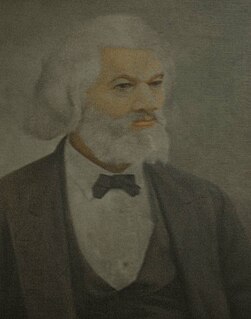
Recorder of deeds or Deeds registry is a government office tasked with maintaining public records and documents, especially records relating to real estate ownership that provide persons other than the owner of a property with real rights over that property.

Glenmore Homestead is a heritage-listed homestead at Belmont Road, Parkhurst, Rockhampton Region, Queensland, Australia. It was built from c. 1858 to c. 1920. The homestead and associated buildings once belonged to pastoral run on the Fitzroy River, seven kilometres northwest of Rockhampton, Queensland. Originally much larger at 127 square miles the current size of the property is 20 acres (8.1 ha). It was added to the Queensland Heritage Register on 21 October 1992.

The Langham is a luxury apartment building located at 135 Central Park West on the Upper West Side of Manhattan, New York City. After the site was unused for more than 15 years, the building was constructed between 1905 and 1907. Built at a cost of US $2 million, the structure included modern amenities, such as ice accessible from every apartment. The building was designed in the French Second Empire style by architects Clinton and Russell. It was listed as a contributing property to the federal government designated Central Park West Historic District on November 9, 1982.

Cloncurry Courthouse is a heritage-listed courthouse at 42-48 Daintree Street, Cloncurry, Shire of Cloncurry, Queensland, Australia. It was designed by Department of Public Works (Queensland) and built in 1897 by Murray and Litster. It is also known as Cloncurry Court House. It was added to the Queensland Heritage Register on 21 October 1992.

Clancholla is a heritage-listed villa at 25 Ward Street, The Range, Rockhampton, Rockhampton Region, Queensland, Australia. It was built c. 1922. It was added to the Queensland Heritage Register on 12 January 2003.
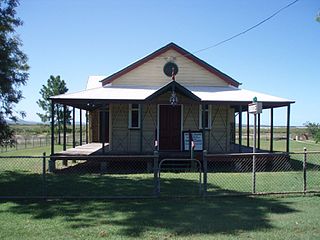
St Lawrence Police Station is a heritage-listed police station and former courthouse at Macartney Street, St Lawrence, Isaac Region, Queensland, Australia. It was built from 1878 to 1934. It is also known as former St Lawrence Courthouse and Cell Block. It was added to the Queensland Heritage Register on 24 November 2000.

Charters Towers Police Station is a heritage-listed police station at 49 Gill Street, Charters Towers, Charters Towers Region, Queensland, Australia. It was designed by Thomas Pye and built in 1910 by T Johnson. It is also known as Police Barracks. It was added to the Queensland Heritage Register on 21 October 1992.

Einasleigh Hotel is a heritage-listed hotel at Daintree Street, Einasleigh, Shire of Etheridge, Queensland, Australia. It was built from 1908 to 1909. It is also known as Central Hotel. It was added to the Queensland Heritage Register on 6 February 2006.

Boulia Stone House is a heritage-listed detached house at Pituri Street, Boulia, Shire of Boulia, Queensland, Australia. It was built circa 1880s to 1890s. It was added to the Queensland Heritage Register on 21 October 1992.

Royal Hotel is a heritage-listed former hotel, former hospital and now ruin at Adelaide Street, Birdsville, Shire of Diamantina, Queensland, Australia. It was built c. 1883. It was later known as Australian Inland Mission Hospital, AIM Hostel, and Birdsville Nursing Home. It was added to the Queensland Heritage Register on 21 October 1992.
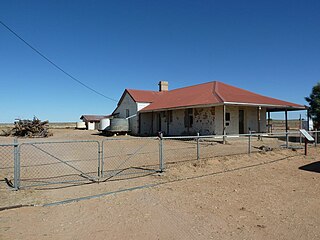
Birdsville Courthouse is a heritage-listed courthouse at Adelaide Street, Birdsville, Shire of Diamantina, Queensland, Australia. It was designed by the Queensland Department of Works and built from 1888 to 1890 by J Wookey and Henry Walton. It was added to the Queensland Heritage Register on 21 October 1992.

Avon Terrace it is the main street of the town of York, Western Australia, and is lined with heritage buildings.

Dinsdale's Shoe Emporium is a heritage-listed building on Avon Terrace in York, Western Australia, constructed by a former mayor.

Faversham House is a heritage-listed "grand residence" overlooking Avon Terrace in York, Western Australia. The house, named after the birthplace of John Henry Monger Snr, was built in four stages by the Monger family.
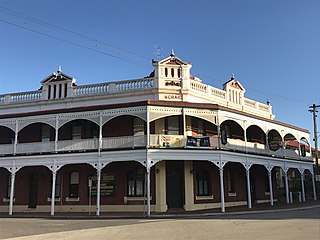
The Castle Hotel in York is reputedly the oldest inland hotel in Western Australia. It was constructed and owned by the Craig family for 137 years.
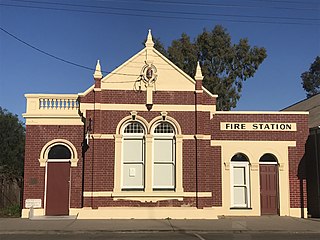
The York Fire Station is a single-storey red brick building originally constructed for the York Municipal Council as Council Chambers in 1897, in York, Western Australia.
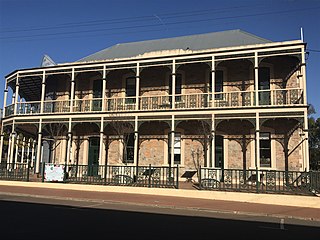
The Imperial Hotel was the first hotel to be built in York, Western Australia that adopted the new "Australian hotel" style in hotel design, with a dominant position on a main street corner block, high and ornate double verandahs surrounding the façade and a main entrance onto the street. The building is in Victorian Filigree style.

Camperdown Post Office is a heritage-listed post office at 190 Manifold Street, Camperdown, Victoria, Australia. It was initially designed by John James Clark and built by Richard Pimblett in 1863. Alterations in 1880, 1882 and 1887 were designed by John Hudson Marsden and built by McCrae & Fullarton. Further 1909 alterations were possibly designed by Horace Mackennal under the aegis of John Smith Murdoch and were built by Alex J. Laurie. It was added to the Australian Commonwealth Heritage List on 8 November 2011.
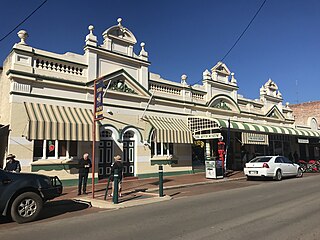
The York Motor Museum is a motor vehicle museum on Avon Terrace in York, Western Australia. It is housed in a group of shops and commercial premises "unified by a classical parapet with classical cappings and balusters" constructed by the Windsor family in 1908.

Settlers House is a historic hotel in the centre of York, Western Australia.





















